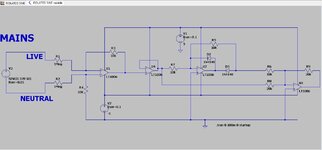cupoftea
Advanced Member level 5
Hi,
We need a train of precision rectified sines, in phase with mains voltage........but we need it variable in magnitude.
We can do the train of half sines bit (its attached)...but how to make these smoothly variable in magnitude down to zero volts? Variable gain opamps dont seem to exist...we want it variable by putting in a control voltage , say..
....We dont want to use a hand twiddled pot either....because the resolution isnt good enough and the wiper "slips".
This waveform doesnt have to supply any current.
We need approx 1 volt peak....down to zero volts peak...(sorry but you know what i mean!)
We need a train of precision rectified sines, in phase with mains voltage........but we need it variable in magnitude.
We can do the train of half sines bit (its attached)...but how to make these smoothly variable in magnitude down to zero volts? Variable gain opamps dont seem to exist...we want it variable by putting in a control voltage , say..
....We dont want to use a hand twiddled pot either....because the resolution isnt good enough and the wiper "slips".
This waveform doesnt have to supply any current.
We need approx 1 volt peak....down to zero volts peak...(sorry but you know what i mean!)
Attachments
Last edited:
